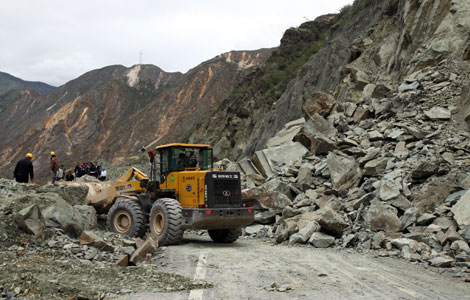Could the smog be vacuumed away?
Updated: 2013-10-28 10:45
By Erik Nilsson (chinadaily.com.cn)
|
||||||||
 |
|
Photo provided to China Daily |
Dutch designer Daan Roosegaarde is building a giant "electronic vacuum cleaner" — the world's largest air purifier — to suck smog from Beijing's skies.
It could turn a 1 kilometer diameter ring of poisonous haze into a 1-centimeter-diameter ring of a condensed particulate that people could wear.
Roosegaarde said the condensed smog "gets squished together" and turns into a sort of gel that can be fashioned into jewelry.
"The smog ring is one example of many possibilities," he told China Daily.
While the particles would be toxic to inhale as particulates, they would be safe to wear on a person's finger as concentrates, he said.
The vacuum is a mass of underground copper coils that generate an electrostatic charge that draws in smog particles.
"It's a similar principle to if you have a statically charged balloon that attracts your hair," Roosegaarde told Dezeen Magazine.
"If you apply that to smog to create fields of static electricity of ions, you literally attract or magnetize the smog so it drops down and you can clean it. It's like an electronic vacuum cleaner."
Roosegaarde told Dezeen that he had the idea for the project while staying at a hotel in Beijing and looking at the CCTV building from his window. "I could see the CCTV building," he said. "I had a good day when I could see it and I had a bad day when I could not see it. On a bad day the smog is completely like a veil. You don't see anything. I thought, that's interesting. That's a design problem."
"We've been working on a series on interactive landscapes," said the designer whose previous creations include dance floors that produce electricity from the people strutting their stuff on them and "smart highways" that generate their own light.
"We thought it would be interesting to use smog as a design component."
Roosegaarde has already developed a prototype and plans to install the first machine within in a little over a year, hopefully in a Beijing park.
But while the technology might appear to suggest a paradigm shift to blue skies, Roosegaarde believed it is no panacea.
"It's not the answer to smog," he said. "But it's making people aware there are solutions. The solution to smog is human, not technological. We should change the way we behave."

 Post-baby Duchess
Post-baby Duchess
 Victoria Beckham S/S 2014 presented during NYFW
Victoria Beckham S/S 2014 presented during NYFW
 'Despicable' minions upset Depp's 'Lone Ranger' at box office
'Despicable' minions upset Depp's 'Lone Ranger' at box office
 'Taken 2' grabs movie box office crown
'Taken 2' grabs movie box office crown
 Rihanna's 'Diamonds' tops UK pop chart
Rihanna's 'Diamonds' tops UK pop chart
 Fans get look at vintage Rolling Stones
Fans get look at vintage Rolling Stones
 Celebrities attend Power of Women event
Celebrities attend Power of Women event
 Ang Lee breaks 'every rule' to make unlikely new Life of Pi film
Ang Lee breaks 'every rule' to make unlikely new Life of Pi film
Most Viewed
Editor's Picks

|

|

|

|

|

|
Today's Top News
3 die after car crash at Tian'anmen Square
ABC apologizes for offensive words on Chinese
NQ Mobile hits back after US stock plunge
Jewelry exhibit dazzles Southern California
Obama aware of spying on Merkel: German paper
High speed versus history
States gear up for symposium
Cousin killed mom, 4 kids
US Weekly

|

|






